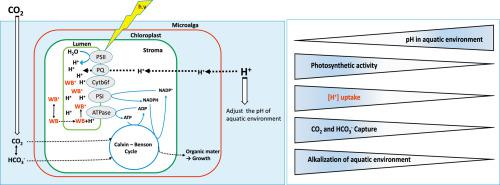Journal of Environmental Management ( IF 8.0 ) Pub Date : 2021-04-08 , DOI: 10.1016/j.jenvman.2021.112546 Sotirios Zerveas , Melpomeni Sofia Mente , Dimitra Tsakiri , Kiriakos Kotzabasis

|
The photosynthetic process in microalgae and the extracellular proton environment interact with each other. The photosynthetic process in microalgae induces a pH increase in the aquatic environment as a result of cellular protons uptake rather than as an effect of CO2 consumption. The photosynthetic water photolysis and the reduction/oxidation cycle of the plastoquinone pool provide lumen with protons. Weak bases act as “permeant buffers” in lumen during the photosynthetic procedure, converting the ΔpH to Δψ. This is possibly the main reason for continuous light-driven proton uptake from the aquatic environment through cytosol and stroma, into the lumen. The proton uptake rate and, therefore, the microalgal growth is proportional to the light intensity, cell concentration, and extracellular proton concentration. The low pH in microalgae cultures, without limitation factors related to light and nutrients, strongly induces photosynthesis (and proton uptake) and, consequently, growth. In contrast, the mitochondrial respiratory process, in the absence of photosynthetic activity, does not substantially alter the culture pH. Only after intensification of the respiratory process, using exogenous glucose supply leads to significantly reduced pH values in the culture medium, almost exclusively through proton output. Enhanced dissolution of atmospheric CO2 in water causes the phenomenon of ocean acidification, which prevents the process of calcification, a significant process for numerous phytoplankton and zooplankton organisms, as well for corals. The proposed interaction between microalgal photosynthetic activity and proton concentration in the aquatic environment, independently from the CO2 concentration, paves the way for new innovative management strategies for reversing the ocean acidification.
中文翻译:

微藻的光合作用可以独立于CO 2浓度吸收H +,从而引起水生环境的碱化–环境应用的新观点
微藻的光合作用过程与细胞外质子环境相互作用。微藻中的光合作用过程在水生环境中引起pH值增加,这是由于细胞质子的吸收而不是由于CO 2的作用消耗。光合水的光解作用和质体醌库的还原/氧化循环为内腔提供了质子。在光合作用过程中,弱碱充当管腔中的“渗透缓冲液”,将ΔpH转换为Δψ。这可能是光驱动质子从水生环境通过胞质溶胶和基质进入管腔的原因。质子吸收率以及因此的微藻生长与光强度,细胞浓度和细胞外质子浓度成正比。在没有限制与光和营养有关的因素的情况下,微藻培养物中的低pH值会强烈诱导光合作用(和质子吸收),并因此导致生长。相反,在没有光合作用的情况下,线粒体的呼吸过程 基本上不会改变培养液的pH。只有在呼吸过程加剧后,使用外源葡萄糖供应才能导致培养基中的pH值显着降低,几乎完全是通过质子输出。增强大气中CO的溶解水中的2会引起海洋酸化现象,从而阻止钙化过程,这对许多浮游植物和浮游生物以及珊瑚来说都是重要的过程。拟议的水生环境中微藻光合作用与质子浓度之间的相互作用,独立于CO 2浓度,为逆转海洋酸化的新的创新管理策略铺平了道路。











































 京公网安备 11010802027423号
京公网安备 11010802027423号